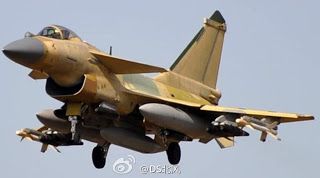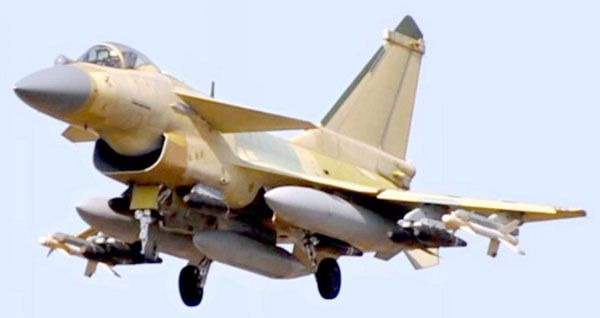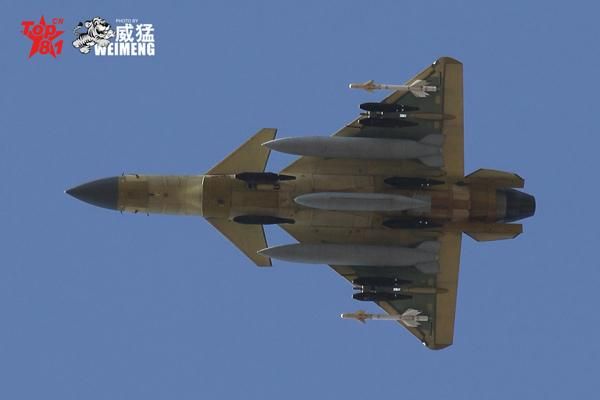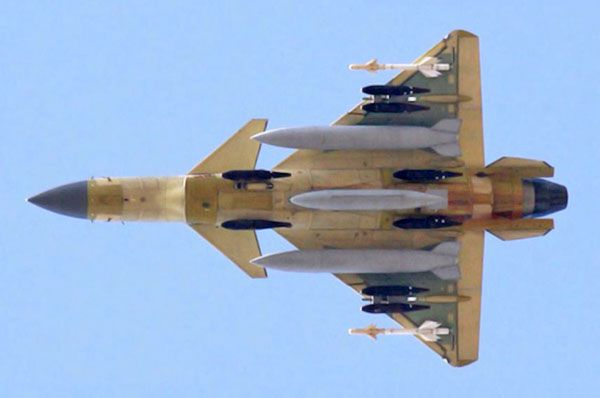You are using an out of date browser. It may not display this or other websites correctly.
You should upgrade or use an alternative browser.
You should upgrade or use an alternative browser.
J-10 Thread III (Closed to posting)
- Thread starter crobato
- Start date
- Status
- Not open for further replies.
kwaigonegin
Colonel
Seems like they really are going with the multi-role route with this bird.
looks like long range A2G role though the bombs look like dumb 500 pounders to me. The AAMs are there for defensive measures only most likely. What's interesting is I do not see any tailfins on the bombs.
You know sometimes I'm left very concerned and even confused
The Sharpe Sword UCAV is a flying wing and tailless design, one of the hardest problems in aerodynamic design and flight control, flying wings are a holy grail in the aviation aeronautics and a very tough problem to solve
Yet Chinese engineers have shown this example, yet still it was fitted with RD-03, likewise the J10B is a fantastic design and I would rank it up there with the Typhoon and Rafale, yet we see AL-31
I wish I could know the inter works and problems the Chinese turbofans are facing
Personally I believe that materials science and quality control are the major drawbacks that Chinese engineers face. China's comparative weakness in building engines has been a long known fact. Even back in the 1990s I remember hearing members of my family talk about how China could build cars but not reliable motors, even to this day many Chinese automobile manufacturers still must import motors and gearboxes.
I also recall them saying how China could build military planes but not commercial jets. I think this is justified by the fact that commercial planes must pass more stringent standards of reliability, and China simply did not have the ability to maintain the required level of consistency in quality control due to the aviation firms being state owned. (no adequate incentives or disincentives: no rewards for most workers in case of success, no chance of losing jobs in case of failure)
Aerodynamic design has benefited tremendously in recent years from computer aided design and modelling, and thusly I think China has been able to make some breakthroughs in the area. Building engines however is a process that requires highly advanced materials science (not so easy to model) which are often closely guarded trade secrets held by a few firms in the most advanced countries. Compound the difficulties of achieving breakthroughs in materials science under military embargo with perhaps persistent issues of quality control, and we have the situation at hand.
SinoSoldier
Colonel
¦^��: Re: New J-10 Thread III
Indeed. However another factor may be that China is cutting too many corners to achieve the speed and production quantity it wants at the cost of reliability or service life, knowing that it can simply build more to replace it.
Personally I believe that materials science and quality control are the major drawbacks that Chinese engineers face. China's comparative weakness in building engines has been a long known fact. Even back in the 1990s I remember hearing members of my family talk about how China could build cars but not reliable motors, even to this day many Chinese automobile manufacturers still must import motors and gearboxes.
I also recall them saying how China could build military planes but not commercial jets. I think this is justified by the fact that commercial planes must pass more stringent standards of reliability, and China simply did not have the ability to maintain the required level of consistency in quality control due to the aviation firms being state owned. (no adequate incentives or disincentives: no rewards for most workers in case of success, no chance of losing jobs in case of failure)
Aerodynamic design has benefited tremendously in recent years from computer aided design and modelling, and thusly I think China has been able to make some breakthroughs in the area. Building engines however is a process that requires highly advanced materials science (not so easy to model) which are often closely guarded trade secrets held by a few firms in the most advanced countries. Compound the difficulties of achieving breakthroughs in materials science under military embargo with perhaps persistent issues of quality control, and we have the situation at hand.
Indeed. However another factor may be that China is cutting too many corners to achieve the speed and production quantity it wants at the cost of reliability or service life, knowing that it can simply build more to replace it.
Re: ¦^��: Re: New J-10 Thread III
perhaps that's what china does with some of its gear but i think engines are a different story. if that were the case we'd see all chinese planes fitted with disposable domestic motors instead of what's going on now. additionally, i don't think motors are something you want to intentionally cut corners on; a well built motor is cheap compared to the potential cost of a losing a plane with all its avionics and crew.
Indeed. However another factor may be that China is cutting too many corners to achieve the speed and production quantity it wants at the cost of reliability or service life, knowing that it can simply build more to replace it.
perhaps that's what china does with some of its gear but i think engines are a different story. if that were the case we'd see all chinese planes fitted with disposable domestic motors instead of what's going on now. additionally, i don't think motors are something you want to intentionally cut corners on; a well built motor is cheap compared to the potential cost of a losing a plane with all its avionics and crew.
Building engines however is a process that requires highly advanced materials science (not so easy to model) which are often closely guarded trade secrets held by a few firms in the most advanced countries. Compound the difficulties of achieving breakthroughs in materials science under military embargo with perhaps persistent issues of quality control, and we have the situation at hand.
They could be putting more effort into the next generation manufacturing process "3D printing technology" for engine components. NASA are already testing/making engine parts this way.
vesicles
Colonel
Re: ¦^��: Re: New J-10 Thread III
I don't think China is cutting corners on engines. Based on what we see with how China proceeds with the CV-16, we know that China takes its time and does not rush thing a bit. Sometimes, we actually think China is taking unnecessarily long time on things, like carrier training. Whatever problem they have with engines, they are working hard to solve them.
perhaps that's what china does with some of its gear but i think engines are a different story. if that were the case we'd see all chinese planes fitted with disposable domestic motors instead of what's going on now. additionally, i don't think motors are something you want to intentionally cut corners on; a well built motor is cheap compared to the potential cost of a losing a plane with all its avionics and crew.
I don't think China is cutting corners on engines. Based on what we see with how China proceeds with the CV-16, we know that China takes its time and does not rush thing a bit. Sometimes, we actually think China is taking unnecessarily long time on things, like carrier training. Whatever problem they have with engines, they are working hard to solve them.
Hendrik_2000
Lieutenant General
Personally I believe that materials science and quality control are the major drawbacks that Chinese engineers face. China's comparative weakness in building engines has been a long known fact. Even back in the 1990s I remember hearing members of my family talk about how China could build cars but not reliable motors, even to this day many Chinese automobile manufacturers still must import motors and gearboxes.
I also recall them saying how China could build military planes but not commercial jets. I think this is justified by the fact that commercial planes must pass more stringent standards of reliability, and China simply did not have the ability to maintain the required level of consistency in quality control due to the aviation firms being state owned. (no adequate incentives or disincentives: no rewards for most workers in case of success, no chance of losing jobs in case of failure)
Aerodynamic design has benefited tremendously in recent years from computer aided design and modelling, and thusly I think China has been able to make some breakthroughs in the area. Building engines however is a process that requires highly advanced materials science (not so easy to model) which are often closely guarded trade secrets held by a few firms in the most advanced countries. Compound the difficulties of achieving breakthroughs in materials science under military embargo with perhaps persistent issues of quality control, and we have the situation at hand.
This is gross misconception and misunderstanding of the machine design process . China has been supplier of gas turbine components, aside from first stage turbine blade, to the like of GE and Snecma for along time just google it, If their material is not up to snuff they won't be qualified in the first place Because those company impose very stringent quality requirement beside the standard ISO and other governing body.
Now lets talk about the first stage turbine blade . This is probably the most severe environment that any engine part will ever see and the most guarded secret that an company ever had. They are not going to give it away. Some of the commercial gas turbine in Industry. Ge has no problem transferring technology to China But when it come to the first stage turbine blade GE insists on manufacturing it themselves.
Because the first blade turbine see temperature , high pressure from the combustion and high load from centrifugal forces
Turbine blades are subjected to very strenuous environments inside a gas turbine. They face high temperatures, high stresses, and a potentially high vibration environment. All three of these factors can lead to blade failures, which can destroy the engine, and turbine blades are carefully designed to resist those conditions.[4]
Turbine blades are subjected to stress from centrifugal force (turbine stages can rotate at tens of thousands of revolutions per minute (RPM)) and fluid forces that can cause fracture, yielding, or creep[nb 1] failures. Additionally, the first stage (the stage directly following the combustor) of a modern turbine faces temperatures around 2,500 °F (1,370 °C),[5] up from temperatures around 1,500 °F (820 °C) in early gas turbines.[6] Modern military jet engines, like the Snecma M88, can see turbine temperatures of 2,900 °F (1,590 °C).[7] Those high temperatures weaken the blades and make them more susceptible to creep failures. The high temperatures can also make the blades susceptible to corrosion failures. Finally, vibrations from the engine and the turbine itself (see blade pass frequency) can cause fatigue failures.
Fatigue and creep is the single most dangerous mode of failure on this turbine blade Of this creep is the hardest to overcome because creep will occur when the material is subjected to high stress and temperature it occur along the grain boundary of the material no matter which material it is .so the solution is to developed single crystal material with no boundary
Creep is more severe in materials that are subjected to heat for long periods, and near their melting point. Creep always increases with temperature.
The rate of this deformation is a function of the material properties, exposure time, exposure temperature and the applied structural load. Depending on the magnitude of the applied stress and its duration, the deformation may become so large that a component can no longer perform its function — for example creep of a turbine blade will cause the blade to contact the casing, resulting in the failure of the blade. Creep is usually of concern to engineers and metallurgists when evaluating components that operate under high stresses or high temperatures. Creep is a deformation mechanism that may or may not constitute a failure mode
Now coming back to China . China has research and developing single crystal blade for a long time and I forgot last year or 2011 the scientist that developer of the material got a public commendation for the success of the material and credited with the improvement of AL 31 engine life. It is buried somewhere in WS 10A thread. I am too lazy to dig it
Another thing if material is the problem most of J 11 B will be falling from the sky regularly. Any accident due to material failure will catastrophic.
We never heard of such thing. Then what is the problem of Chines Gas turbine I believe it is more to do with reliability . Now what cause the reliability problem. Reliability is inversely proportional to the number of components. the more component the less reliable is the engine.
The number of component is the function of design and certain extend components supplier. Now here China has problem since there is no viable commercial airplane manufacturer in China .She has to developed the supplier base(ecosystem) from the scratch . The supplier in turn won't put too much effort and money in design research and development if they can't divide the cost of R&D over large number of product.
Unlike in US or Europe were the components suppliers are first class and have developed their own R&D over long time
In another thing the supplier ecosystem and sophistication in China turbine supplier is not developed yet .Therefore is is imperative to developed the commercial aircraft manufacturing in China because it feed to the military side
Now how to reduce the number of components and improve the reliability of the engine . People often forget that WS 10A only enter serial production around 2010. So it is very young engine that need refinement over some period of time. And the designer can only tweak the design if they have more operation data from large number of sample which now they have with the introduction of J11B.
It is one thing building prototype from test stand and manufacturing production machine that operate under real condition.
So give China more time and they will increase the reliability of WS 10A. So all the snipping and condescending comment is unwarranted. It is too early to write off WS 10A as failure. In fact yesterday saw a new J11B with Taihang engine for PLAN regiments WS10A is alive and kicking
Every engine encountered teething problem when they first introduced even the fame F100 that power early J 16
The F100 engine was first tried in service with the F-15 Eagle. The Air Force had hoped that the F100 engine would be a mature and reliable powerplant by the time that the F-16 was ready to enter service. However, there were a protracted series of teething troubles with the F100 powerplants of the F-15, compounded by labor problems at two of the major subcontractors. Initially, the Air Force had grossly underestimated the number of engine powercycles per sortie, since they had not realized how much the F-15 Eagle's maneuvering capabilities would result in abrupt changes in throttle setting. This caused unexpectedly high wear and tear on the engine, resulting in frequent failures of key engine components such as first-stage turbine blades. Most of these problems could be corrected by more careful maintenance and closer attention to quality control during manufacturing of engine components. Nevertheless, by the end of 1979, the Air Force was being forced to accept engineless F-15 airframes until the problems could be cleared up.
However, the most serious problem with the F100 in the F-15 was with stagnation stalling. Since the compressor blades of a jet engine are airfoil sections, they can stall if the angle at which the airflow strikes them exceeds a critical value, cutting off airflow into the combustion chamber which results in a sudden loss of thrust. Such an event is called a stagnation stall. Stagnation stalls most often occurred during high angle-of-attack maneuvers, and they usually resulted in abrupt interruptions of the flow of air through the compressor. This caused the engine core to lose speed, and the turbine to overheat. If this condition was not quickly corrected, damage to the turbine could take place or a fire could occur.
Last edited:
- Status
- Not open for further replies.





